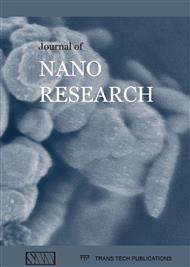[1]
Nagase K., Zheng Y., Kodama Y. and Kakuta J., Journal of Catalysis; 1999; 187: 123-130.
Google Scholar
[2]
Yin M., Wu C. K., Lou, Y., Burda C., Koberstein J. T. and Zhu Y., Journal of American Chemical Society; 2005; 127: 9506-9511.
DOI: 10.1021/ja050006u
Google Scholar
[3]
Zhang V., Liu J., Peng Q., Wang X. and Li Y., Chemistry of Materials; 2006; 18: 867-871.
Google Scholar
[4]
Wu H., Lin D. and Pan W., Applied Physics Letters; 2006; 89: 1-3.
Google Scholar
[5]
Poizot P., Laruelle S., Grugeon S., Dupontl L., Tarascon J. M., Nature; 2000; 407; 496-99.
Google Scholar
[6]
Hsieh C. T., Chen J. M., Lin H. H. and Shih H. C., Applied Physics Letters; 2003; 83: 3383-3385.
Google Scholar
[7]
Wu M. K., Ashburn J. R., Torng C. J., Hor P. H., Meng R. L. and Gao L., Physics Revised Letters; 1987; 58: 908-910.
Google Scholar
[8]
Chang M. H., Liu H. S. and Tai C. T., Powder technology; 2011; 207: 378-386.
Google Scholar
[9]
Chen J. T., Zhang F., Wang J., Zhang G. A., Miao B. B., Fan X. Y., Yan D. and Yan P. X., The Journal of Alloys and Compounds; 2008; 454: 268-273.
DOI: 10.1016/j.jallcom.2006.12.032
Google Scholar
[10]
Yu L., Zhang G., Wu Y., Bai X., Guo D., Journal of Crystal Growth; 2008: 310: 3125-30.
Google Scholar
[11]
Zhu J., Bi H., Wang Y., Wang X., Yang X., Lu L., Materials Letters; 2007; 61: 5236-5238.
Google Scholar
[12]
Su Y. K., Shen C. M., Yang H. T., Li H. L. and Gao H. J., The Transactions of Nonferrous Metals Society of China; 2007; 17: 783-786.
Google Scholar
[13]
Yuan G. Q., Jiang H. F., Lin C., Liao S. J., Journal of Crystal Growth; 2007; 303: 400-406.
Google Scholar
[14]
Zhang H., Li S., Ma X., Yang D., Materials Research Bulletin; 2008; 43; 1291-1296.
Google Scholar
[15]
Zhang M., Xu X., Zhang M., Materials Letters; 2008; 62: 385-388.
Google Scholar
[16]
Ma M. G., Zhu Y. J., The Journal of Alloys and Compounds; 2008; 455; 15-18.
Google Scholar
[17]
Chen Z. Z., Shi E. W., Zheng Y. Q., Li W. J., Xiao B., Zhuang J. Y., Journal of Crystal Growth; 2003; 249: 294-300.
Google Scholar
[18]
Zhang Y. C., Tang J. Y., Wang G. L., Zhang M., Hu X.Y., Journal of Crystal Growth; 2006; 294: 278-282.
Google Scholar
[19]
Tang X. L., Ren L., Sun L. N., Tian W. G., Cao M. H. and Hu C. W., Chemical Research in Chinese Universities; 2006; 22: 547-551.
Google Scholar
[20]
Song X., Yu H., Sun S., Journal of Colloid and Interface Science; 2005; 289: 588-591.
Google Scholar
[21]
Keyson D., Volanti D. P., Cavalcante L. S., Simões A. Z., Varela J. A. and Longo E., Materials Research Bulletin; 2008; 43: 771-775.
DOI: 10.1016/j.materresbull.2007.03.019
Google Scholar
[22]
Xu X., Zhang M., Feng J. and Zhang M., Materials Letters; 2008; 62: 2787-2790.
Google Scholar
[23]
Yang Z., Xu J., Zhang W., Liu A. and Tang S., Journal of Solid State Chemistry; 2007; 180: 1390-1396.
Google Scholar
[24]
Callister W. D., Rethwisch D. G., Fundamentals of Materials Science and Engineering, John Wiley & Sons, third edition, (2007).
Google Scholar
[25]
Das M. A., Nam S. H., Kim Y. S. and W. B. Kim, Journal of Solid State Electrochemical; 2010; 14: 1719-1726.
Google Scholar
[26]
Zou G. F., Li H., Zhang D., Xiong W., Dong K. and Qian C., The Journal of Physical Chemistry; 2006; 110: 1632-1637.
Google Scholar
[27]
Kliche K. and Popovic Z. V., Physical Review Letters; 1990; 42: 10060-10066.
Google Scholar
[28]
Balamurunga B. and Mehta B. R., Thin Solid Films; 2001; 396: 90-96.
Google Scholar
[29]
Tsunekawa S., Fukuda T., Kasuya A., Journal of Applied Physics; 2000; 87: 1318-1321.
Google Scholar
[30]
Santra K., Sarkar C. K., Mukherjee M. K., Cosh B., Thin Solid Films; 1992; 213: 226-229.
Google Scholar


